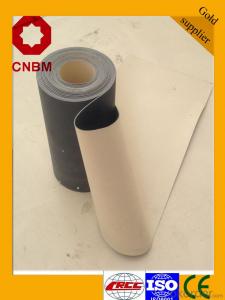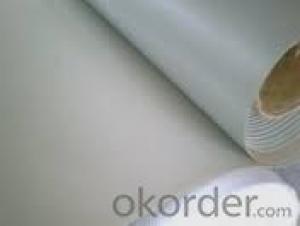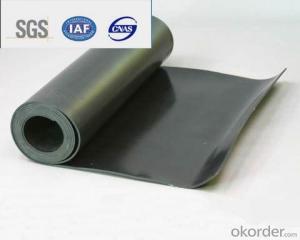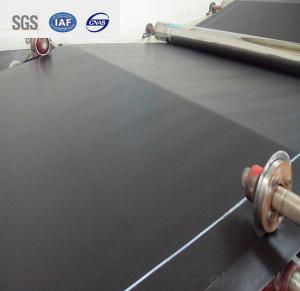Strong cross-membrane reaction type self-adhesive waterproof membrane
- Loading Port:
- China main port
- Payment Terms:
- TT OR LC
- Min Order Qty:
- 10 m²
- Supply Capability:
- 80000 m²/month
- Option:
- 1m*20m
OKorder Service Pledge
OKorder Financial Service
You Might Also Like
Item specifice
01 Product introduction Product Introduction
Strong cross-film reactive self-adhesive waterproof coil is a kind of high performance, cold construction reactive bond waterproof coil made of special cross-layer high density polyethylene (HDPE) strong film and high quality polymer reactive binder by special process composite. It has super bonding performance with concrete, high porosity sealing, excellent dimensional stability. Uv resistance and tear resistance. The strong cross-film of the product is a high-strength HDPE film formed by cross-lamination process. The longitudinal and horizontal elongation of the film film made by this process is the same, and the roll will not be deformed, which is more beautiful and waterproof effect is more reliable. The high-quality pressure-sensitive adhesive layer can be quickly combined with the concrete base. Its excellent self-healing properties and local self-locking water properties greatly reduce the penetration probability. The polymer in the strong film reacts with the cement compound in a series of reactions, forming an interpenetrating network structure, and finally forming a continuous mechanical bond, which is permanently sealed on the cement cementitious material member.
02 Product characteristics
1. The polyester strong film has higher tearing strength and dimensional stability, which solves the phenomenon that the tire free self-adhesive polymer waterproof coil is easy to wrinkle after construction;
2. Has excellent bonding performance, and the structure to achieve full bonding, to achieve the best waterproof effect of the coil and the structure layer, and effectively prevent water channeling phenomenon;
3. Highly featured self-healing function, which can make local damaged points heal themselves;
4. Excellent high and low temperature resistance, can adapt to climate change;
5. Excellent extensibility and tensile properties, greatly adapt to the deformation of the structure base;
6. Leading construction technology, can use hot paving, dry paving, wet paving and pre-paving construction, wet base can be used, improve the construction conditions in different environments, while saving time;
7. No pollution, energy saving, safety and environmental protection.
03 Applicable scope
1. Underground engineering, underground garage roof, planting roof, roof garden;
2. Subway, tunnel engineering, pool, roof engineering;
3. Waterproof with corrosion and large deformation of structure;
4. Other warehouses and workshops with high requirements for waterproof and moisture-proof.
04 Packaging and storage andtransportation
1. When storing and transporting, different types and specifications of products should be stacked separately and should not be mixed. Avoid sun and rain, pay attention to ventilation, away from fire.
2. The storage temperature should not be higher than 45℃, the horizontal storage of the coil shall not exceed 5 layers, and the vertical storage shall be stacked in a single layer.
3. Prevent tilt or side pressure during transportation, and cover the tarpaulin if necessary.
4. Under normal transportation and storage conditions, the storage period is 1 year from the date of production.
- Q:Can waterproofing membranes be used on terraces?
- Yes, waterproofing membranes can definitely be used on terraces. In fact, using waterproofing membranes on terraces is highly recommended to protect the structural integrity of the terrace and prevent water damage. Waterproofing membranes act as a barrier, preventing water from seeping into the terrace and causing leaks or cracks. They are commonly used on flat terraces, rooftop terraces, and balconies to ensure that water does not penetrate the surface and cause damage to the underlying structure. Waterproofing membranes are available in various types, such as liquid-applied membranes, sheet membranes, and self-adhesive membranes, providing different options to suit the specific needs and requirements of the terrace. By applying a waterproofing membrane, the terrace can be protected from moisture, UV rays, and other environmental factors, extending its lifespan and ensuring a durable and long-lasting surface.
- Q:Can a waterproofing membrane be used for a dam?
- Yes, a waterproofing membrane can be used for a dam. It can effectively prevent water leakage and seepage, ensuring the structural integrity of the dam and its ability to hold and control water.
- Q:Can a waterproofing membrane be used for hospitals or healthcare facilities?
- Yes, a waterproofing membrane can be used for hospitals or healthcare facilities. Waterproofing membranes are commonly used in these types of buildings to protect the structure from moisture damage and prevent water leakage, which is crucial for maintaining a safe and hygienic environment. The waterproofing membrane helps to create a barrier against water infiltration, ensuring the longevity and integrity of the building and safeguarding the health and well-being of patients and staff.
- Q:Can a waterproofing membrane be used on precast galvanized surfaces?
- Yes, a waterproofing membrane can be used on precast galvanized surfaces. The waterproofing membrane is designed to provide a protective barrier against water penetration, and it can be applied to various surfaces including precast galvanized surfaces. The membrane helps to prevent water from seeping into the surface, protecting the underlying structure from moisture damage. However, it is important to ensure that the precast galvanized surface is properly prepared before applying the membrane, as any loose or flaking galvanized coating should be removed to ensure proper adhesion of the membrane. Additionally, it is advisable to consult with the manufacturer or supplier of the waterproofing membrane to ensure that it is compatible with galvanized surfaces and to follow their recommended application guidelines for best results.
- Q:What are the benefits of using a waterproofing membrane?
- There are several benefits of using a waterproofing membrane, especially in construction projects or areas that are exposed to moisture or water. Firstly, a waterproofing membrane helps to prevent water penetration, which is crucial in protecting the structural integrity of a building or infrastructure. Water can seep through cracks or joints, causing damage to the foundation, walls, or floors. By applying a waterproofing membrane, it creates a barrier that prevents water from infiltrating and causing potential structural issues. Secondly, waterproofing membranes can help to prevent the growth of mold and mildew. Moisture and excess water can create a breeding ground for mold, which not only damages the aesthetics of a space but also poses health risks. By using a waterproofing membrane, it keeps moisture out and reduces the chances of mold growth, creating a healthier and safer environment. Additionally, a waterproofing membrane can help to increase the lifespan of a structure. By preventing water intrusion, it protects the building materials from deterioration caused by moisture. This can save on repair and maintenance costs in the long run, as the structure remains in good condition for a longer period of time. Furthermore, waterproofing membranes can also contribute to energy efficiency. By sealing off any gaps or cracks, it helps to retain heat or cool air inside a building, reducing energy consumption and improving insulation. This can lead to significant energy savings and lower utility bills. Lastly, using a waterproofing membrane can provide peace of mind. Knowing that a building or structure is protected from water damage, mold growth, and potential structural issues brings a sense of security and confidence, particularly in areas prone to heavy rainfall, flooding, or high moisture levels. In conclusion, the benefits of using a waterproofing membrane are numerous. It protects against water damage, prevents mold growth, increases the lifespan of a structure, improves energy efficiency, and provides peace of mind. Whether it is for residential, commercial, or industrial purposes, incorporating a waterproofing membrane is a wise investment that ensures the longevity and durability of a building or infrastructure.
- Q:Can a waterproofing membrane be used on cinder block surfaces?
- Yes, a waterproofing membrane can be used on cinder block surfaces. It provides an effective barrier against water penetration and helps to protect the cinder block from moisture-related damage.
- Q:Can waterproofing membranes be used on concrete planters?
- Yes, waterproofing membranes can be used on concrete planters to prevent water leakage and protect the concrete from moisture damage.
- Q:Can a waterproofing membrane be used in temporary or temporary structures?
- Indeed, temporary or transient structures can benefit from the utilization of a waterproofing membrane. These specialized membranes are crafted to establish a safeguard against the infiltration of water, a critical measure in thwarting any potential moisture-related harm in various architectural formations. Be it a fixed or impermanent construction, such as a provisional refuge, tent, or temporary worksite, the application of a waterproofing membrane guarantees the attainment of water resistance and protection. Consequently, it becomes imperative to meticulously select a waterproofing membrane that aligns with the distinct requisites of the temporary structure, while adhering to the appropriate installation protocols to ensure its utmost efficacy.
- Q:Does a waterproofing membrane require a protective layer?
- Yes, a waterproofing membrane typically requires a protective layer. The protective layer helps to shield the membrane from various external factors, such as UV rays, weather conditions, mechanical damage, and chemical exposure, thereby enhancing its durability and longevity.
- Q:Can a waterproofing membrane be used in residential construction?
- Residential construction can indeed utilize a waterproofing membrane. These membranes find common usage in different parts of a residential property, such as roofs, basements, bathrooms, and foundations. Their purpose is to prevent water from penetrating and causing damage due to moisture. By opting for a waterproofing membrane, homeowners can ensure that their property remains dry and free from water leaks. This is crucial because such leaks can result in mold growth, structural deterioration, and other costly problems. The market offers a variety of waterproofing membranes, such as sheet membranes, liquid membranes, and self-adhering membranes, each with its own advantages and suitability for specific applications. Consulting with a professional contractor or architect can assist in determining the most suitable waterproofing membrane for a particular residential construction project.
1. Manufacturer Overview |
|
|---|---|
| Location | |
| Year Established | |
| Annual Output Value | |
| Main Markets | |
| Company Certifications | |
2. Manufacturer Certificates |
|
|---|---|
| a) Certification Name | |
| Range | |
| Reference | |
| Validity Period | |
3. Manufacturer Capability |
|
|---|---|
| a)Trade Capacity | |
| Nearest Port | |
| Export Percentage | |
| No.of Employees in Trade Department | |
| Language Spoken: | |
| b)Factory Information | |
| Factory Size: | |
| No. of Production Lines | |
| Contract Manufacturing | |
| Product Price Range | |
Send your message to us
Strong cross-membrane reaction type self-adhesive waterproof membrane
- Loading Port:
- China main port
- Payment Terms:
- TT OR LC
- Min Order Qty:
- 10 m²
- Supply Capability:
- 80000 m²/month
- Option:
- 1m*20m
OKorder Service Pledge
OKorder Financial Service
Similar products
New products
Hot products
Hot Searches
Related keywords




























